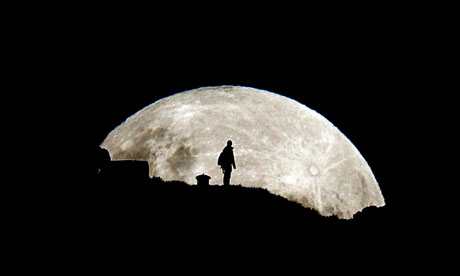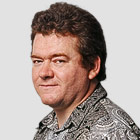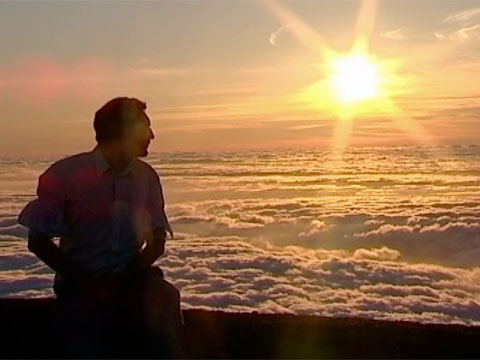Photographers took spectacular shots of this year's "supermoon", the visual spectacle that occurs once a year when the full moon is closest to the Earth. Pictures showed the giant moon dwarfing observers and looming over hillsides as if it was approaching the Earth in a science-fiction scenario.
It's beautiful that we can still get excited by looking at the moon. It was there before humans were and has been observed and portrayed for thousands of years. It was by looking ever more closely at the moon that people realised what it actually is. Art and science meet in early astronomy.
In the middle ages, the sky was understood to be a celestial canopy above the fixed Earth, and the sun and moon were imagined as moving in the heavens over our stationary platform. This world view is sweetly represented in Raphael's painting the Mond Crucifixion, which literally shows the sun and moon as personified luminous beings in the sky above the Earth. It is a lovely childlike image of the cosmos. Yet a few years after Raphael painted his flat Earth, the theorist Copernicus would think beyond such ancient models. Copernicus in the early 16th century postulated that the Earth orbits the sun and not the other way round. His theory was abstract. To prove it would need visual evidence.
In the early 17th century, the Italian scientist Galileo Galilei got his hands on one of the first telescopes and improved this Dutch invention. He turned it on the moon and made, for the first time, detailed observations of the surface of Earth's nearest neighbour. As he points out in his book The Starry Messenger, the moon is covered with mountains and craters and what look like seas. In other words, it is not a light in the sky but a rocky body like our own planet. This was a fundamental piece of evidence pointing to the nature of the Earth itself, as one sphere in space among others. It helped Galileo defend the new cosmos of Copernicus – and to get his point across, he used art. Galileo recorded his observations of the moon's surface in beguiling drawings that were engraved and printed in The Starry Messenger.
In centuries to come, telescopes improved and ever more accurate pictures of the moon were recorded. In the 1790s, John Russell made a drawing of the surface of the moon that is so precise and detailed it looks like a photograph taken by a spacecraft approaching Earth's satellite. This amazing piece of astronomical art comes from the era of the Enlightenment when people marvelled at science, as shown in Wright of Derby's painting The Orrery. The model of the solar system, which Wright portrays people reacting to with such curiosity and awe, is a modern view in which Copernicus and Galileo are vindicated.
But the thing is – when you look at this year's supermoon, it is quite easy to see geographical features of the moon with the naked eye. Since these features can be seen without a telescope, why did it take a telescope to point them out? How could the moon be imagined as an ethereal light when its physical qualities are visible to the eye? That must be because you have to know what to look for in order to see it. The evidence of eye alone is not enough.











